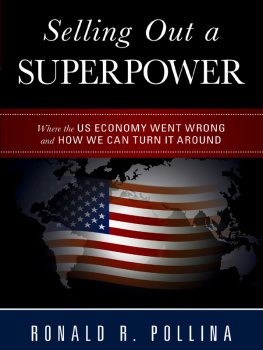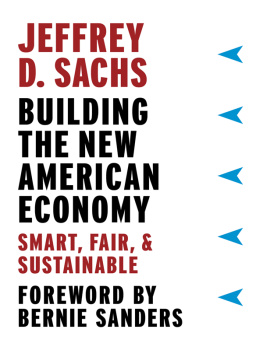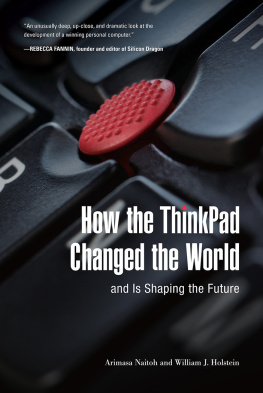Why GM Matters:
Inside the Race to Transform an American Icon
Manage the Media
(Dont Let the Media Manage You)
The Japanese Power Game:
What It Means for America
THE
NEXT AMERICAN
ECONOMY
Blueprint for a Real Recovery

WILLIAM J. HOLSTEIN

Copyright 2011 by William J. Holstein
All rights reserved. No part of this book may be used or reproduced in any manner whatsoever without written permission from the publisher except in the case of brief quotations embodied in critical articles or reviews. For information address Walker & Company, 175 Fifth Avenue, New York, NY 10010.
Published by Walker Publishing Company, Inc., New York
LIBRARY OF CONGRESS CATALOGING-IN-PUBLICATION DATA
Holstein, William J.
The next American economy : blueprint for a real recovery /
William J. Holstein.1st U.S. ed.
p. cm.
Includes bibliographical references.
ISBN 978-0-8027-7750-8
1. IndustriesUnited StatesCase studies. 2. Diffusion of innovationsUnited StatesCase studies.
3. New productsUnited StatesCase studies. 4. Job creationUnited StatesCase studies. 5. Industrial policyUnited States. 6. United StatesCommerce. 7. United StatesEconomic conditions2009I. Title.
HC106.84.H67 2011
338.973dc22
2010040502
First published in the U.S. by Walker Publishing Company in 2011
This e-book edition published in 2011
E-book ISBN: 978-0-8027-7866-6
Visit Walker & Companys Web site at www.walkerbooks.com
CONTENTS
Introduction:
PART I
ONE :
How Innovation Happens in a Premier Hot Spot
TWO :
Pittsburgh Attempts to Reinvent
THREE :
Orlandos Simulation Boom
FOUR :
San Diegos Genomics Industry Attracts World-Class Talent
FIVE :
Cornings Gorilla Glass
PART II
SIX :
Austin Mobilizes to Tap Renewable Energy
SEVEN :
North Carolina Builds Its High-Tech Exports
EIGHT :
Atlanta Lures Back Manufacturing from Abroad
NINE :
Cleveland Retrains Displaced Workers
PART III
TEN
ELEVEN
TWELVE : The Case for Onshoring
THIRTEEN
INTRODUCTION
I T IS A TIME OF DESPERATION in many quarters of the American economy. By most estimates, the United States needs to create at least 10 million to 12 million jobs to repair the damage that a devastating recession has inflicted, even if that recession is technically over. As of September 2010, some 14.9 million Americans who wished to find employment could not do soand roughly half of them have been out of work for more than six months, a level not seen since the Great Depression in the 1930s. In general, they have a sense that they have lost control of the nations economic destiny. When asked about Americas economic future, some cynics respond by joking darkly, Do we have one?
But the United States does have a future, and the heart of Americas innovation engine still beats. It is not just twenty-five-year-olds coming up with Facebook applications or sleek new gadgets for Apple and Google. Americans of many ages, geographies, and industries are attempting to give birth to new industriesthin-film solar and other renewable forms of energy, simulation and modeling, advanced robotics, lithium-ion batteries, nanotechnology, biotech and genomics, and new materials, to name just a few. The creation of new industries is what America has traditionally done better than any other country in the world. From the transistor and X-ray to the Internet and biotechnology, America has always created new technologies that disrupt the established order and change the world. The best aspect of the United States is the breadth of the thinking, says Willy C. Shih, a professor at Harvard Business School and veteran of twenty-eight years at IBM, Digital Equipment, Silicon Graphics, and Eastman Kodak. Because of the intellectual environment, we have the most wide-open big thinkers. This is the place where you get the really far-out ideas that turn out to be importantFacebook and Google but also the transistor and the integrated circuit.
The problem is that these new ideas are not taking root fast enough and arent creating enough jobs on U.S. soil, an essential gap that economists do not understand. Many of them argue that Americans can simply wait for the economy to get better, assuming that easy credit will flow again and Americans can return to the free-spending ways that prevailed during a prolonged financial bubble, when either stock market prices or real estate values fueled the economy and consumer spending accounted for two-thirds of all economic activity. Every time newly reported consumer spending or consumer confidence statistics are weak, these economists are disappointed. Prominent economists, including some on the White Houses Council of Economic Advisers, insist that the United States needs only to wait for a turn in the business cyclewhat is called a cyclical recovery.
But they are wrong to expect the economy to simply get better and wrong to expect consumer spending to reemerge as such a dominant force in the economy. If doctors misdiagnose a patient, they cannot possibly offer the right treatment. Thats what mainstream economists are doing todaynot recognizing the depth of the structural challenge that the U.S. economy faces as it engages with the powerhouses of East Asia. The economy needs change of a sort that will open up the valves of American innovation and create new industries, while beginning to ease the U.S. dependency on imported energy. It needs change at the microeconomic level, where Americans live, work, and shop. The goal that unites the nation should be to figure out how true wealth is created, while at the same time addressing the issue of energy dependency. Those two goals are not mutually exclusive. In fact, they are deeply connected.
It has been my lifes work to study the creation of wealth from the ground up. I have been reporting and writing about it since I was a young correspondent for United Press International (UPI). After President Jimmy Carter normalized American relations with China in late 1978, UPI recognized that it needed more correspondents in Asia and assigned me to Hong Kong. Part of my job was covering nearby southern China, which emerged as ground zero in Chinas economic modernization efforts because it was where four special economic zones were to be built. China was an inward-looking, entirely socialist country. Vast seas of Chinese in their olive-green Mao jackets bicycled through the dark streets of the southern city of Guangzhou at night, the whirling of their wheels creating the only sounds. They were poor and had spent decades engaged in ideological struggles against each other. Now their paramount leader, Deng Xiaoping, had told them that to get rich is glorious.
In one of the special economic zones, the Chinese wanted to build a dock to load and unload ships, but a mountain of one or two thousand feet in height blocked access to the water. Many foreign correspondents did not think the Chinese could ever break free from socialism and class struggle, but I watched thousands of Chinese laborers as they took the mountain down, stone by stone. Several dozen men were at the top with pickaxes, and then brigades of other laborers with wheelbarrows would carry the stones back down the mountain. There wasnt a single piece of mechanized equipment, not a single Caterpillar machine, to be seen. The Chinese were going to build wealth because they could focus their huge manpower on achieving a common objectivethe way they were able to organize and focus their labor was their competitive advantage in a capitalist world. It was the beginning of Chinas emergence, and also the beginning of my understanding of the complex concept now called globalization.
Next page








